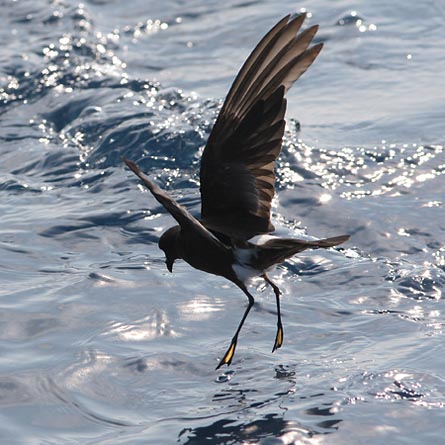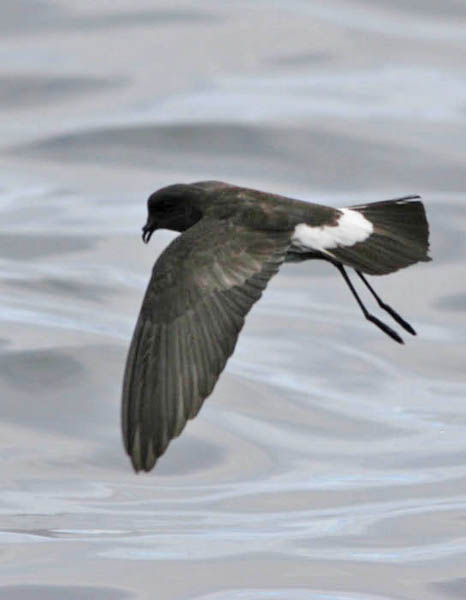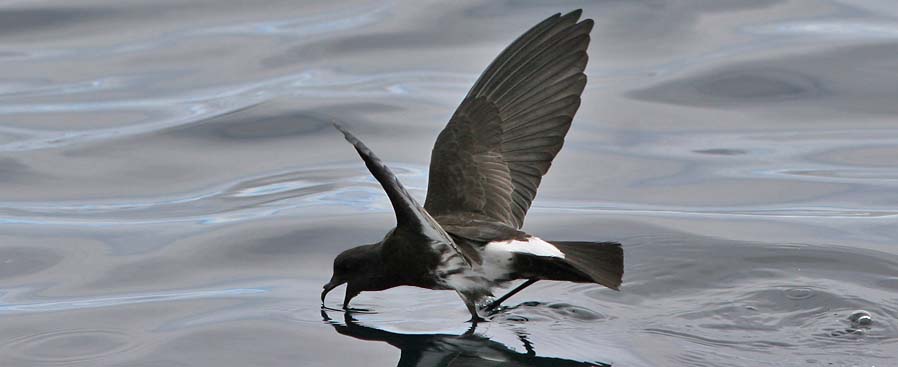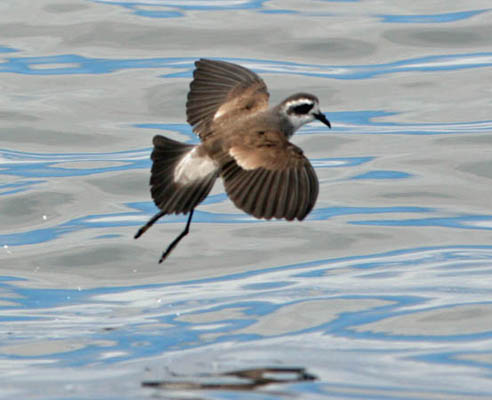| |
AUSTRAL STORM-PETRELS Oceanitidae |
- 9 species worldwide in current taxonomy
- DR personal total: 6 species (66%), 4 photo'd
|
 Storm-petrels
are small aerial seabirds found in all oceans of the world. Recently
they have been split into two families, as genetic evidence reveals
that ancestors of northern and tropical species diverged from ancestors
of austral species about 30 million years ago (Jarvis et al. 2014, Prum
et al. 2016). Some research suggested that two groups may not even be
each other's nearest relatives (Penhallurick & Wink 2004, Hackett
et al. 2008). It is now best to consider them two families: Austral
Storm-Petrels [Oceanitidae] and Northern Storm-Petrels [Hydrobatidae]. Storm-petrels
are small aerial seabirds found in all oceans of the world. Recently
they have been split into two families, as genetic evidence reveals
that ancestors of northern and tropical species diverged from ancestors
of austral species about 30 million years ago (Jarvis et al. 2014, Prum
et al. 2016). Some research suggested that two groups may not even be
each other's nearest relatives (Penhallurick & Wink 2004, Hackett
et al. 2008). It is now best to consider them two families: Austral
Storm-Petrels [Oceanitidae] and Northern Storm-Petrels [Hydrobatidae].
Watching Wilson's Storm-Petrel
patter over the water (above & left), one can well imagine the
tales that were spun by ancient mariners. Some seafarers of old called
them "Mother Carey's chickens," in reference to the Virgin Mary (Mater cara)
to whom the protection of sailors was commended. Wilson's Storm-Petrel
breeds on southern hemisphere islets and disperses north widely
thereafter. The are huge numbers in the Atlantic; some believe the
species to be among the most abundant birds in the world in sheer
numbers. Many fewer reach the north Pacific, but they are annual in our
autumn on Monterey Bay in California. |
Wilson's Storm-Petrel breeds around Antarctica and on subAntarctic islands; another race (chilensis)
breeds in the Cape Horn region of Chile. Most of the Austral
Storm-Petrels are birds of the southern oceans but Elliott's
Storm-Petrel Oceanites gracilis is a partial exception. The
nominate race has been found breeding on islands off Chile (most of its
breeding range remains unknown) but there is a breeding race (O. g. galapagoensis) on the Equator in the Galapagos Islands.
Some of the austral storm-petrels are quite wonderful to watch, and one of those is White-faced Storm-Petrel
(both photos below). This amazing storm-petrel uses its very long legs
to 'push off' of wavelets, thus bounding and gliding across the surface
of the sea as if on a pogo-stick. I'd only had one brief encounter
before, in the eastern tropical Pacific, in 1989, so to watch 70 in the
Hauraki Gulf off North Island, New Zealand, in 2009 was superb. Plus,
by then, there were digital cameras! |
|

Polynesian Storm-Petrel Nesofregetta fulginosa
also has this astonishing flight pattern, seeming to skip of the water
erratically each time it glides down, careening from point-to-point
like the mechanically ball in the old "Pong" video game.
Storm-petrels,
like other members of the order Procellariiformes, have specially
modified "tubes" atop their bills. This special organ, which you can
see on the White-faced Storm-Petrel (above left), allows them to drink
salt water and then dispose of the salt. One can sometimes see drops of
concentrated salt being "sneezed" out of these tubes.
Among
the many White-faced Storm-Petrels attracted to the chum laid out for
them on my 2009 trip was — suddenly appearing out of nowhere — was the
bird we had most wanted to see: New Zealand Storm-Petrel (right
& below). A few were collected in the 1800s but it disappeared from
the known avian world thereafter and was considered extinct. It was
only re-discovered in the Hauraki Gulf in 2003 (Gaskin & Baird
2005), and now appears to be regular there in the austral summer. Its
nest and fledglings were found on Little Barrier Island in 2009 (Raynor
et al. 2013). |
|
| |
Photos: The shots of Wilson's Storm-Petrel Oceanites oceanicus were off Hatteras, North Carolina, on 14 June 2009. Photos of the White-faced Storm-Petrel Pelagodroma marin and New Zealand Storm-Petrel Fregetta maoriana were from a boat in the Hauraki Gulf, New Zealand, on 14 Nov 2009.
All photos © Don Roberson; all rights reserved.
Bibliographic essay
There
are many seabird books, but apparently none which can strictly be
called a family book on the Storm-Petrels (there are monographs on
individual species, however). A very fine introduction to the family,
with a selection of nice photos, is in Carboneras (1992). Photographs
of all species are in Harrison (1987), and art and text in his earlier
work (Harrison 1983b). The photographs are quite nice, but one must be
careful with the text (esp. of the earlier book) which contains
numerous errors. There is also still much to glean from Murphy (1936).
A new book that includes storm-petrels among Atlantic procelarids is
Robb et al. (2008); it includes not only a lively text and lovely
photos, but CDs with extended samples of storm-petrel calls at night.
Literature cited:
- Boswell, J. 1979. Flight characters of Wilson's Petrel. Brit. Birds 72: 330-334, 386.
- Brown, R. G. B. 1980. Flight characteristics of Madeiran Petrel. Brit. Birds 73: 263-264.
- Carboneras, C. 1992. Family Hydrobatidae (Storm-Petrels) in del Hoyo, J., Elliott, A., & Sargatal, J., eds. Handbook of the Birds of the World. Vol. 1. Lynx Edicions, Barcelona.
- Christidis, L, and W.E. Boles. 2008. Systematics and taxonomy of Australian Birds. CSIRO Publ, Sydney.
-
Crossin, R. S. 1974. The storm petrels (Hydrobatidae), in Pelagic
studies of seabirds in the central and eastern Pacific Ocean (W. B.
King, ed.), pp.154-205. Smithsonian Contr. Zool. 158.
- Gaskin,
C.P., and K.A. Baird. 2005. Observations of black and white storm
petrels in the Hauraki Gulf, November 2003 to June 2005. Were they of
New Zealand storm-petrels? Notornis 52: 181–194.
- Hackett,
S.J.. R.T. Kimball, S. Reddy, R.C.K. Bowie, E. L. Braun, M. J. Braun,
J.L. Chojnowski, W. A. Cox, K.-L. Han, J. Harshman, C.J. Huddleston,
B.D. Marks, K.J. Miglia, W.S. Moore, F.H. Sheldon, D.W. Steadman, C. C.
Witt, and T. Yuri. 2008. A phylogenomic study of birds reveals their
evolutionary history. Science 320: 1763–1768.
- Harrison, P. 1983a. Identification of white-rumped North Atlantic petrels. Brit. Birds 76: 161-174.
- Harrison, P. 1983b. Seabirds: An Identification Guide. Houghton Mifflin, Boston.
-
Harrison, P. 1987. Seabirds of the World: a Photographic Guide.
Bromley, England: Christopher Helm. [Published in the U.S. as Field
Guide to the Seabirds of the World, Lexington, MA.: Stephen Greene
Press]
- Jarvis, E.D., S. Mirarab, A.A. Aberer, B.
Li, P. Houde, et al. 2014. Whole-genome analyses resolve early branches
in the tree of life of modern birds. Science 346: 1320–1331.
- Murphy, R. C. 1936. Oceanic Birds of South America. 2 vols. Amer. Mus. Nat. Hist., New York.
-
Naveen, R. 1981-1982. Storm-petrels of the world: an introductory guide
to their identification. Birding 13: 216-239; 14: 10-15, 56-62, 140-147.
- Penhallurick,
J. and M. Wink. 2004. Analysis of the taxonomy and nomenclature of the
Procellariiformes based on complete nucleotide sequences of the
mitochondrial cytochrome b gene. Emu 104: 125-147.
- Rayner,
M.J., C.P. Gaskin, B.M. Stephenson, N.B. Fitzgerald, T.J. Landers, B.C.
Robertson, P.R. Scofield, S.M.H. Ismar, and M.J. Imber. 2013. Brood
patch and sex ratio observations indicate breeding provenance and
timing in New Zealand storm petrel (Fregetta maoriana). Marine
Ornithology 41: 107–111.
- Robb, M., Mullarney, K.,
and Sound Approach. 2008. Petrels Night and Day: A Sound Approach
Guide. The Sound Approach: Dorset, UK.
|
|
|



 Storm-petrels
are small aerial seabirds found in all oceans of the world. Recently
they have been split into two families, as genetic evidence reveals
that ancestors of northern and tropical species diverged from ancestors
of austral species about 30 million years ago (Jarvis et al. 2014, Prum
et al. 2016). Some research suggested that two groups may not even be
each other's nearest relatives (Penhallurick & Wink 2004, Hackett
et al. 2008). It is now best to consider them two families: Austral
Storm-Petrels [Oceanitidae] and Northern Storm-Petrels [Hydrobatidae].
Storm-petrels
are small aerial seabirds found in all oceans of the world. Recently
they have been split into two families, as genetic evidence reveals
that ancestors of northern and tropical species diverged from ancestors
of austral species about 30 million years ago (Jarvis et al. 2014, Prum
et al. 2016). Some research suggested that two groups may not even be
each other's nearest relatives (Penhallurick & Wink 2004, Hackett
et al. 2008). It is now best to consider them two families: Austral
Storm-Petrels [Oceanitidae] and Northern Storm-Petrels [Hydrobatidae]. 

